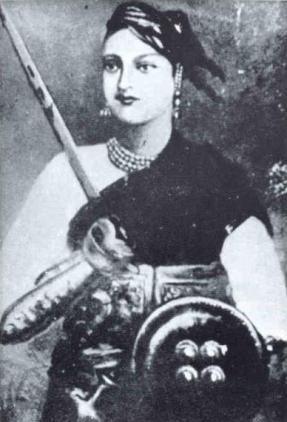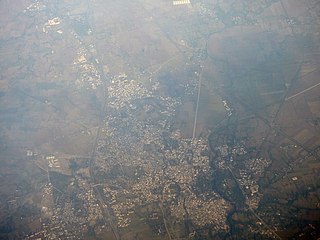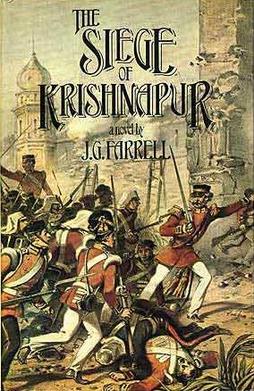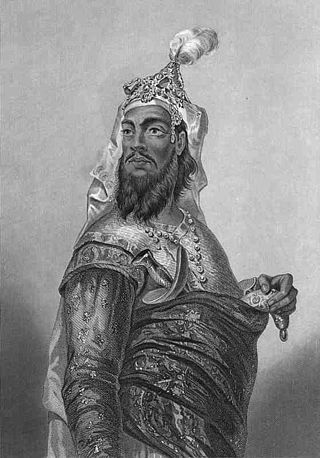
Lakshmibai Newalkar, the Rani of Jhansi, was the Maharani consort of the princely state of Jhansi in Maratha Empire from 1843 to 1853 by marriage to Maharaja Gangadhar Rao Newalkar. She was one of the leading figures in the Indian Rebellion of 1857, who became a national hero and symbol of resistance to the British rule in India for Indian nationalists.

The Indian Rebellion of 1857 was a major uprising in India in 1857–58 against the rule of the British East India Company, which functioned as a sovereign power on behalf of the British Crown. The rebellion began on 10 May 1857 in the form of a mutiny of sepoys of the company's army in the garrison town of Meerut, 40 mi (64 km) northeast of Delhi. It then erupted into other mutinies and civilian rebellions chiefly in the upper Gangetic plain and central India, though incidents of revolt also occurred farther north and east. The rebellion posed a military threat to British power in that region, and was contained only with the rebels' defeat in Gwalior on 20 June 1858. On 1 November 1858, the British granted amnesty to all rebels not involved in murder, though they did not declare the hostilities to have formally ended until 8 July 1859.

Stadtlohn is a city in western Münsterland in the northwest of North Rhine-Westphalia, and is a district town of the Borken administrative district. The city had a population of 20,746 inhabitants as of 2020. The River Berkel flows through the city on its way to the Netherlands.

The siege of Cawnpore was a key episode in the Indian rebellion of 1857. The besieged East India Company forces and civilians in Cawnpore were duped into a false assurance of a safe passage to Allahabad by the rebel forces under Nana Sahib. Their evacuation from Cawnpore thus turned into a massacre, and most of the men were killed and women and children taken to a nearby dwelling known as Bibighur. As an East India Company rescue force from Allahabad approached Cawnpore, 120 British women and children captured by the rebels were butchered in what came to be known as the Bibighar Massacre, their remains then thrown down a nearby well. Following the recapture of Cawnpore and the discovery of the massacre, the angry Company forces engaged in widespread retaliation against captured rebel soldiers and local civilians. The murders greatly enraged the British rank-and-file against the Sepoy rebels and inspired the war cry "Remember Cawnpore!".

Begum Hazrat Mahal, also known as the Begum of Awadh, was the second wife of Nawab of Awadh Wajid Ali Shah, and the regent of Awadh in 1857–1858. She is known for the leading role she had in the rebellion against the British East India Company during the Indian Rebellion of 1857.

Chatra district is district one of the twenty-four districts of Jharkhand state, India. The district was formed after separation from Hazaribagh district in 1991. Chatra is the administrative headquarters of this district. The district covers an area of 3718 km2.

Basti district is one of the districts of Uttar Pradesh state, India, and a part of Basti Division. Basti city is the district headquarters.

Bulandshahr, formerly Baran, is a city and a municipal board in Bulandshahr district in the state of Uttar Pradesh, India.

The Bareilly district belongs to the state Uttar Pradesh in northern India. Its capital is Bareilly city and it is divided in six administrative division or tehsils: Aonla, Baheri, Bareilly city, Faridpur, Mirganj, and Nawabganj. The Bareilly district is a part of the Bareilly Division and occupies an area of 4120 km2 with a population of 4,448,359 people according to the census of 2011.

Sehore is a city and a municipality in Sehore district in the Indian state of Madhya Pradesh. It is the district headquarters of Sehore District and is located on the Bhopal-Sehore-Indore highway, 38 km from Bhopal.

The provinces of India, earlier presidencies of British India and still earlier, presidency towns, were the administrative divisions of British governance on the Indian subcontinent. Collectively, they have been called British India. In one form or another, they existed between 1612 and 1947, conventionally divided into three historical periods:

The Siege of Krishnapur is a novel by J. G. Farrell, first published in 1973.
Harraiya is a town and tehsil in Basti district in the Indian state of Uttar Pradesh.
Jagdambika Pal is an Indian politician. He is a former Chief Minister of Uttar Pradesh. He was also a member of 15th Lok Sabha & 16th Lok Sabha and was a member of Indian National Congress, until he resigned on 7 March 2014.

Kunwar Singh, also known as Babu Kunwar Singh, was a leader and military commander during the Indian Rebellion of 1857. He led a selected band of armed soldiers against the troops under the command of the British East India Company. He was the chief organiser of the fight against the British in Bihar.

Basti is a city, municipal board and administrative headquarters of Basti district in the Indian state of Uttar Pradesh. Basti district is a part of Basti division. It is situated 202 kilometres east of state capital Lucknow.

Tulsipur State was a small kingdom in the Awadh region of India that became the United Provinces of Agra and Oudh under the British Raj and Dundwa Range of the Siwaliks in the Dang and Deukhuri Valleys that became part of the Kingdom of Nepal. It was one of the areas traditionally inhabited by the Tharu people.

Amorha Khas is a gram panchayat in Basti district in the Indian state of Uttar Pradesh. In the freedom struggle of 1857, about 250 martyrs of Amorha State were hanged by the British Government from peepal trees located at Chhawani.
Kharagdiha is a village in the Jamua CD block in the Khori Mahua subdivision of the Giridih district in the Indian state of Jharkhand. It had been known as Curruckdea or Curruckdeah during the British Raj.
Chhawani is a place near Amorha in Basti district in the Indian state of Uttar Pradesh.














